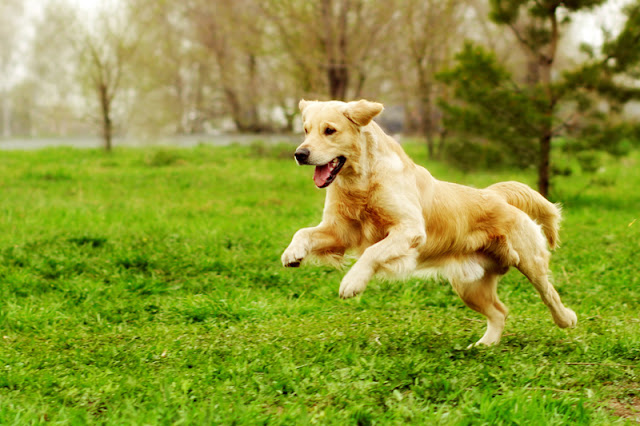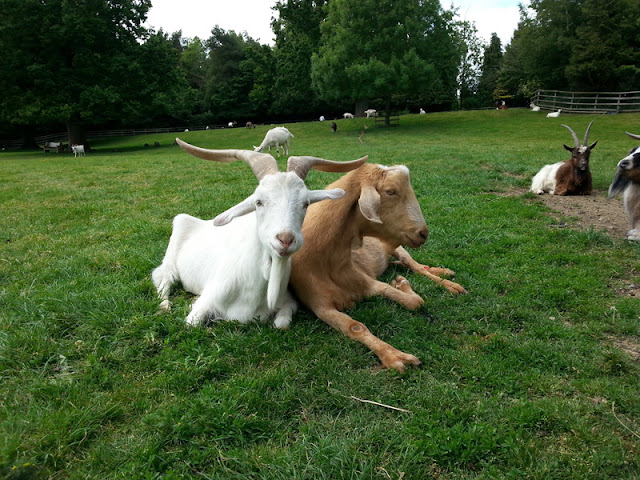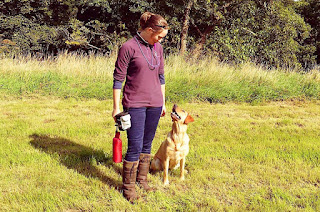Guest post by Kristi Benson CTC
 |
| Photo: Anna Goroshnikova/Shutterstock |
A while ago, a client got in touch asking for help with the family dog. The dog was a young and lovely Golden retriever, smart as a whip and sweet as pie. The problem? He was barking. A lot. As I packed up my bag of tricks, I grabbed a few different hand-outs to make sure I had all the usual suspects covered: boredom barking? Check. Fearful barking? Check. Guarding, alarm, attention, and play? Check, check, check. My bait bag and some treats followed the hand-outs into my bag and I was off to the races.
When a story begins in the middle of some action, it’s called “in medias res”, which is a Latin term meaning "into the middle of things". Have you ever read a thriller that opens with the characters sitting around a table in a tense meeting of political hotshots? Or a murder mystery starting with a car chase, sirens whooping? The story starts part way in, and we, as the readers, must reconstruct what happened to get us to this place, either from the flashbacks that the author doles out, or from the story itself. It makes for some delicious reading, the fictional world opening up before us both forward and backward in time, with each turn of the page. Sometimes there are missing details that we only find out when the twisted threads of the plot are finally brought together, and sometimes there are red herrings that make us imagine we know what’s what, but are simple, or not-so-simple, redirection.
In some ways, this is a great metaphor for dog training. I’m not being arcane, I promise. A dog trainer almost always comes in part way through the story. But instead of a tense political meeting, it’s a dog who is tense around strangers, or fireworks, or at the dog park. Or maybe in the place of a car chase between the good guys and the bad guys, it’s a “dog actually chasing a car” scenario.
"As all of us who not-so-secretly enjoy formulaic fiction can tell you, there is nothing wrong with a formula that works."
When I arrived at my new client’s house, I found a dog who seemed a bit scared of me. He barked when I got in the door, his body lowered and tail tucked. I tossed him treats for a few minutes, over which he began to bark less and less. Once he had warmed to me and my treats, he acted towards me the same way he acted towards his own human family. He was waggling and climbing in my lap and all-round adorably happy. I asked the owners to let me know, in synopsis, all the contexts in which this dog barked. It quickly became clear that all of them had a single thing in common: new people.
 |
| Photo: Monika Wisniewska/Shutterstock |
Dog trainers get good at asking the right questions, or ‘taking history’, as we call it. Just like how an author hands out details to his readers to build a fictional backstory, our clients need to give us important details on the dog’s backstory. We’ll ask, “what causes your dog to react in this way?” We’ll ask, “what makes it better? What makes it worse?” If the dog is biting...how hard? Whom? If the dog is scared, when? A dog trainer will get the details that we need to make a diagnosis, and a plan. We’ll build the backstory, to the degree that it matters.
And that’s actually another way that fictional writing is allegorical to professional dog training: we focus on what matters. The books you read are not ten billion pages. The entire family tree of the main character back to revolutionary France is not included. You do not learn the name of their favourite childhood doll nor the brand of coffee they bought in 1987. You, curled up in an armchair with a mug of mocha and a rare evening all to yourself, learn just what you need to know to make the story work.
And so it is with dog trainers. Our clients have limited resources, and we have limited time with them. We winnow our questions to just the most relevant ones, in order to get the backstory that matters. (In fact, random and wandering, irrelevant questions may be a good indicator that a trainer is out of their league. Spending hours of your time collecting details about stuff that doesn’t relate to the behaviour issue or the training is a worrisome flag in an unregulated field. If in doubt, check for credentials).
 |
| Photo: audrey_l/Shutterstock |
As a dog trainer works with a dog, new details about the dog’s behaviour invariably crop up. Each step in a training plan is like a page turned. We expect the dog to react to men with beards, but in fact, men with hats are more problematic. We expect the dog to jump on guests at the door, but in fact, the dog jumps up in the kitchen. Each detail is added to the dog’s story, and the training plan changes or not, as needed. A plot twist here, a new character there.
This isn’t to say that the training plan we use for most dogs isn’t somewhat formulaic. Many, many dogs share a diagnosis and treatment protocol, because all dogs are...well, dogs, and because issues crop up in relatively predictable spots. Issues reliably crop up when dogs are scared or worried, when dogs are ill, and when dogs are exuberantly joyful in a way that doesn’t fit with their human families. But as all of us who not-so-secretly enjoy formulaic fiction can tell you, there is nothing wrong with a formula that works. Helping dogs and their owners is our primary concern, not post-modern creativity.
"You, curled up in an armchair with a mug of mocha and a rare evening all to yourself, learn just what you need to know to make the story work."
Quite happily for dogs ’round the globe, just as we almost always get resolution in a good book (or at least, we do in the good books I read...see formulaic, above), we almost always get resolution with the dogs we train, too. The lovely young Golden got a standard protocol to reduce his fearfulness around new people, by preventing exposure outside of training, and using desensitization and counterconditioning to change his underlying emotional state when he did come across strangers. And quite predictably, when he was no longer feeling threatened, the fearful barking went away all by itself.
As dog trainers we hop into the middle of a dog’s story, in medias res: the problem started before we got there, and we land on two feet, right into the middle of it. We fill out the backstory by asking questions and by observing the dog for ourselves. And like the most stalwart detective, we work our way through the dog’s story as we train, getting new information from how they respond to the training we propose. Finally, we reach the end of the book: the problem has resolved, or the owner is ready to take the pencil into their own hands and finish the story themselves. Another client, and another story, awaits.
Also by Kristi Benson:
Did we evolve to love dogs?
Digging into our common ground with dogs
About Kristi Benson CTC
Kristi Benson is an honours graduate of the prestigious Academy for Dog Trainers, where she earned her Certificate in Training and Counseling (CTC). She lives and works in the Parkland Region of central Manitoba Canada, where she teaches dog obedience classes and helps dog owners in private consultations – both in-person and via video chat – for a full range of dog problems, from basic obedience to aggressive behaviour. Kristi is on staff at the Academy for Dog Trainers, helping to shape the next generation of canine professionals. Kristi’s dogs are rescue sled dogs, and for fun she runs them with a dog-powered scooter and on skis.
Contact her through her website and check out her blog, Facebook page, or Twitter for training tips, articles about dogs and training, and more.
Read more guest posts at Companion Animal Psychology or check out our guest post guidelines.
As an Amazon Associate I earn from qualifying purchases.
Contact her through her website and check out her blog, Facebook page, or Twitter for training tips, articles about dogs and training, and more.
Read more guest posts at Companion Animal Psychology or check out our guest post guidelines.
As an Amazon Associate I earn from qualifying purchases.











